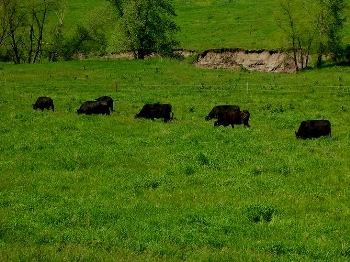Soil Science Society of America
5585 Guilford Road • Madison, WI 53711-5801 • 608-273-8080 • Fax 608-273-2021
www.soils.org
Twitter | Facebook | Soils Matter Blog
NEWS RELEASE
Contact: Hanna Jeske, Associate Director of Marketing and Brand Strategy, 608-268-3972, hjeske@sciencesocieties.org
Grazing Management Effects on Stream Pollutants
MADISON, WI, JULY 21, 2011 -- Surface water quality is important for the proper function of aquatic ecosystems, as well as human needs and recreation. Pasturelands have been found to be major sources of sediment, phosphorus and pathogens in Midwest surface water resources. While poor grazing management may lead to contaminated surface water, little is known about the specific amount of pollution in pasture streams that can be attributed to grazing cattle.
Scientists in the Departments of Animal Science, Veterinary Diagnostic and Production Animal Medicine, and Veterinary Microbiology at Iowa State University and the USDA-ARS National Laboratory for Agriculture and the Environment have studied the effects of grazing management practices on sediment, phosphorus, and pathogen deposits into pasture streams. Results of the study are published in the July/August 2011 issue of the Journal of Environmental Quality.

There were no differences in the amounts of sediment, phosphorus or pathogen deposits in the pasture stream between the different types of stream access given to the cattle. Most of the phosphorus and sediment introduced to the stream was the result of stream bank erosion.
The levels of pathogens cattle deposited into pasture streams were infrequent, and found to be dependent on the distribution of grazing cattle.The amount of pollutants in pasture streams were estimated from six 30-acre pastures in central Iowa for two years. The cattle were given different types of access to the pasture streams. Pollutants transported in precipitation runoff was quantified, and fecal samples were collected and analyzed for their levels of harmful bacteria.
Kirk Schwarte, the graduate student who conducted the study, explains, “While cattle can certainly contribute to the pollution of the streams, implementing simple and practical grazing management practices have the potential to greatly reduce these contributions while continuing to allow the cattle to have controlled access to graze on pasture stream banks.”
Research on the relationship between grazing cattle and the pollution contributed by the cattle of pasture streams is ongoing at Iowa State University. Further research of grazing management techniques includes the evaluation of specific management practices to maintain water quality in pasture streams.
This research was funded with grants from the USDA Cooperative State Research, Education, and Extension Service National Integrated Water Program and National Research Initiative.
###
Journal of Environmental Quality publishes original research, reviews and analyses, and environmental issue articles that address anthropogenic impacts on water, soil, and the atmosphere and pertain to some aspect of environmental quality in natural and agricultural ecosystems.